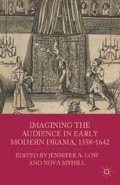Abstract
Throughout the many studies of early modern drama, one interaction has gone relatively unexamined: that of performance and audience. While the early modern audience has long been recognized as central to the early modern stage, it has also, for reasons of evidence and scholarly focus, been curiously set apart from the experience of the drama of the period. There is no shortage of fascinating work on the early modern audience as a demographic entity, and there is a positive superabundance of analysis of individual plays in terms of the society in which they participate—which necessarily includes their audiences. But neither of these views exactly speaks to the other, largely because they tend to view either the audience (in the case of theater history) or the play (in the case of cultural criticism) as a relatively stable entity—one that emerges from its encounter with the other largely the same as it went in. The idea of what can be gained from studying theatrical audiences expands considerably when we recognize performance as a dialectical activity, acknowledging the role of the audience in all stages of the life of the drama as well as the certainty in the early modern period that plays had some effect on their audiences beyond passing their time for two hours.1 Imagined audiences shape dramas at the inception of the composition process as surely as plays ask their audiences to modify their behavior and interpretive practices.
Access this chapter
Tax calculation will be finalised at checkout
Purchases are for personal use only
Preview
Unable to display preview. Download preview PDF.
Notes
Jeremy Lopez, Theatrical Convention and Audience Response in Early Modern England (Cambridge: Cambridge University Press, 2003), 31–32.
Jean Howard, Shakespeare’s Art of Orchestration (Urbana: University of Illinois Press, 1984).
See in particular Andrew Gurr, Playgoing in Shakespeare’s London (Cambridge: Cambridge University Press, 1987), 59–79 and 115–90.
Charles Whitney’s fascinating new book, Early Responses to Renaissance Drama (Cambridge: Cambridge University Press, 2006), takes this practice to, and arguably beyond, its logical conclusion in its focus on “the experience of many individuals” who left behind traces of highly individual responses to early modern plays (5). Lopez disputes the utility of what he characterizes as “dividing audiences into ever smaller and more specific groups.” Lopez, Theatrical Convention, 8. See also Lopez, Theatrical Convention, 16–19.
Gurr, Playgoing, 3. See also Alfred Harbage’s claim that the absence of a twentieth-century Shakespeare is a result of the absence of an audience of sufficient quality. Shakespeare’s Audience (New York: Columbia University Press, 1941), 166.
Stephen Greenblatt, Shakespearean Negotiations (Berkeley: University of California Press, 1988), 5.
Katharine Eisaman Maus and Elizabeth Harvey, eds., introduction to Soliciting Interpretation: Literary Theory and Seventeenth-Century English Poetry (Chicago: Chicago University Press, 1990), x.
Stephen Gosson, Playes Confuted in Five Actions (London, 1582), F7. Further citations in this chapter will appear parenthetically and refer to this edition.
Richard Halpern, The Poetics of Primitive Accumulation (Ithaca, NY: Cornell University Press, 1991), 38. It is also clearly visible in Greenblatt’s insistence that we consider the “pressure” of images as not merely metaphorical in early modern England. Shakespearean Negotiations, 8.
Laura Levine, Men in Women’s Clothing: Anti-theatricality and Effeminization from 1579 to 1642 (Cambridge: Cambridge University Press, 1994), 13.
Thomas Overbury, The Overburian Characters, ed. W. J. Paylor (1614; repr., Oxford: Blackwell, 1936), 92.
Keir Elam, The Semiotics of Theatre and Drama (London: Methuen, 1980), 96.
Richard Brome, The Antipodes, ed. Ann Haaker (Lincoln: University of Nebraska Press, 1966) 5.12.34–39. Parenthetical citations indicate act, scene, and lines.
William Shakespeare, The Tempest. The Riverside Shakespeare, ed. G. Blakemore Evans et al. (Boston: Houghton Mifflin Company, 1974), Epilogue 14. Further citations will appear parenthetically.
Stephen Gosson, The Schoole of Abuse, ed. Edward Arber (London: Alex Murray and Son, 1869), 32. Subsequent page citations appear parenthetically.
Ben Jonson, Induction to Bartholomew Fair, ed. E. A. Horsman (Manchester, UK: Manchester University Press, 1960), 64–67.
John Gordon Sweeney III, Jonson and the Psychology of Public Theater (Princeton, NJ: Princeton University Press, 1985), 9. Sweeney considers Jonson’s attempts to manipulate his audiences through inductions, epilogues, epistles, and the plays themselves. See especially Sweeney, Psychology, 5–15.
Paul Yachnin and Anthony Dawson, The Culture of Playgoing in Shakespeare’s England: A Collaborative Debate (Cambridge: Cambridge University Press, 2001).
Ann Jennalie Cook, The Privileged Playgoers of Shakespeare’s London, 1576–1642 (Princeton, NJ: Princeton University Press, 1981)
Martin Butler, Theatre and Crisis 1632–1642 (Cambridge: Cambridge University Press, 1984).
Ann Jennalie Cook, “Audiences: Investigation, Interpretation, and Invention,” in A New History of Early English Drama, ed. John D. Cox and David Scott Kastan (New York: Columbia University Press, 1997), 306. Cook’s article usefully summarizes the major areas of consensus and dispute in the demographic study of the audiences of early modern England.
For a discussion of critical bias in deciding which demographic account to accept, see Thomas Cartelli, Marlowe, Shakespeare, and the Economy of Theatrical Experience (Philadelphia: University of Pennsylvania Press, 1991), 44–47.
Editor information
Copyright information
© 2011 Jennifer A. Low and Nova Myhill
About this chapter
Cite this chapter
Myhill, N., Low, J.A. (2011). Introduction. In: Low, J.A., Myhill, N. (eds) Imagining the Audience in Early Modern Drama, 1558–1642. Palgrave Macmillan, New York. https://doi.org/10.1057/9780230118393_1
Download citation
DOI: https://doi.org/10.1057/9780230118393_1
Publisher Name: Palgrave Macmillan, New York
Print ISBN: 978-1-349-29310-0
Online ISBN: 978-0-230-11839-3
eBook Packages: Palgrave Theatre & Performance CollectionLiterature, Cultural and Media Studies (R0)

